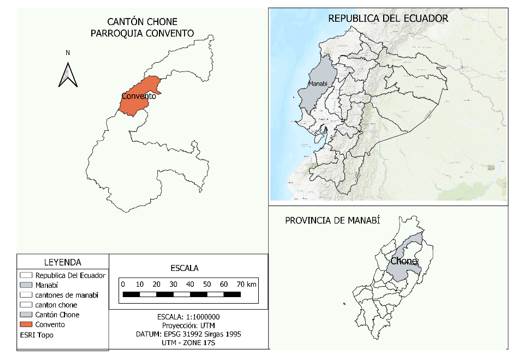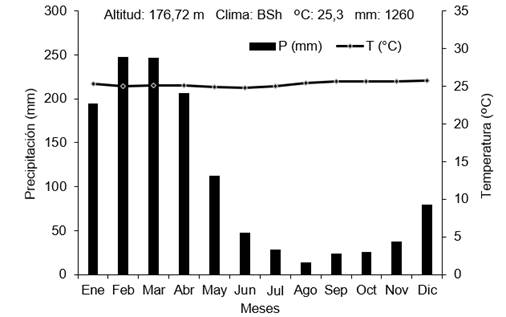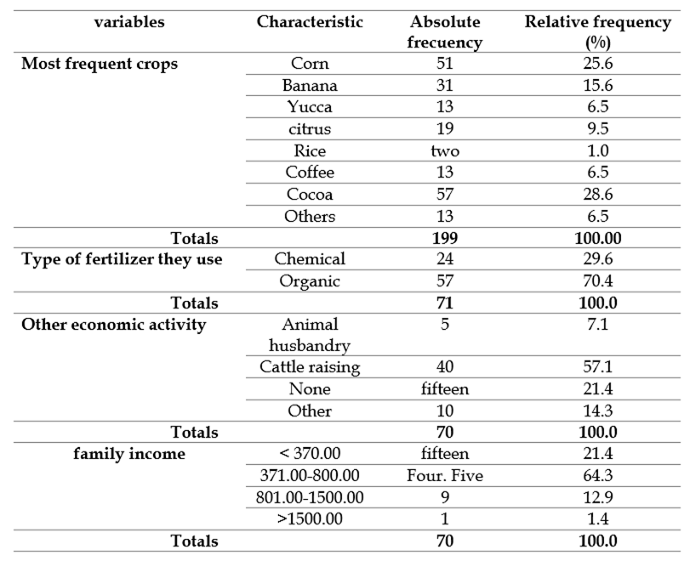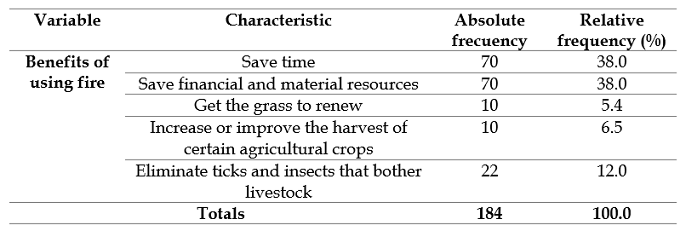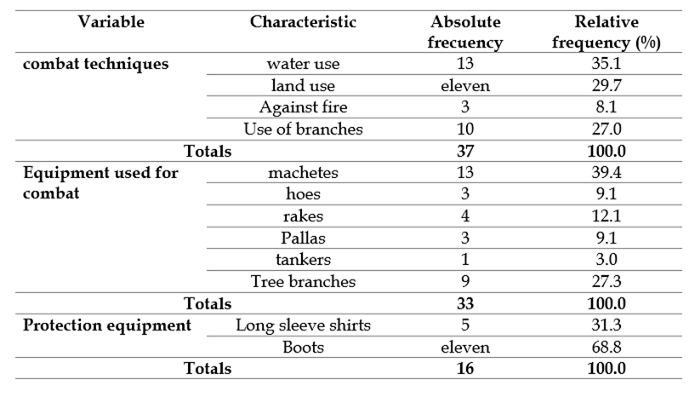Revista Cubana de Ciencias Forestales
ISSN 2310-3469
05--2022
Original article
Traditional uses of fire in the agricultural activities of the Convento parish, Chone canton, Manabí, Ecuador
1Universidad Estatal del Sur de Manabí. Ecuador.
2Empresa King Forest. Ecuador.
3Gobierno Autónomo Descentralizado Municipal La Concordia. Ecuador.
The use of fire by agricultural producers is a common practice that has been used since immemorial times in most countries of the world. The objective of this study was to diagnose the traditional uses of fire in the agricultural activities of the Convento parish, Chone canton, Manabí, Ecuador. The information that forms the diagnosis was obtained by applying a semi-structured survey with open and closed questions to 70 rural producers from the Gaspar site in the Convento parish during the months of October and November 2020. The statistical analysis was carried out with the SPSS program (Version 22.0). The results show that the use of fire in the locality is common and that the majority always burn in the same places. Although they proposed not to burn on specific dates, December was the month most frequently mentioned, with the average burned area being 1.82 ha. The most important purposes of the use of fire in the locality were the burning of agricultural crop residues and the clearing of land for sowing or planting. Building gaps around the area to be burned and to observing the speed and direction of the wind were the main prevention measures taken into account in the locality where fire is used. The perception of the producers about the negative effects caused by the fire could be described as very high, since all the respondents said that the fire damages the soil and the environment. The results can be used by decision makers in the field of fire management.
Key words: Extinction; Forest fires; Fire management; Prevention; Controlled burns.
INTRODUCTION
Fire, dominated by man more than 500,000 years ago, became one of the most important elements for the development of humanity, even superior to the Industrial Revolution, which certainly would not have happened without fire (Soares, Batista and Tetto 2017). The historical knowledge of burning by native peoples contributes to understanding the role that fire plays in natural tropical and temperate ecosystems (Huertas-Herrera et al., 2019).
Burning fulfills several functions: a) increases fertility, peasants believe that it nourishes the land, and thus the maize grows better; b) labor savings, since setting fire costs nothing, and requires little investment of energy and time, and is done in one day; c) pest control, since fire is a great pest controller, as well as cheap (Gutiérrez-Navarro et al., 2017). However, (Pivello 2011), states that fire can and should be used in fire-adapted ecosystems to maintain ecological processes and biodiversity, as long as appropriate regimes are applied, or in the strict traditional sustainable approach.
Prescribed burning has been used for wildfire mitigation, agricultural practices (such as stubble reduction and pasture management), property protection, maintenance of ecological processes, and biodiversity conservation (Morgan et al., 2020). The use of fire is increasingly recognized as a core component of integrated land management in fire-prone locations (Carroll, Edgeley, and Nugent 2021). Nevertheless, sometimes the fire gets out of control, thus starting wildfires, which are responsible for a substantial loss of forest ecosystem services worldwide and represent one of the main driving forces of forest degradation in Latin America and the Caribbean (Souza-Alonso et al., 2022). They can modify the quality of dissolved organic matter in soils and, consequently, have a great influence on the biogeochemical cycles of forest ecosystems (Ide et al., 2020). Fire can affect ecosystem productivity directly through nutrient volatilization, increased mineralization, and alteration of the amount of organic matter, and indirectly through alteration of vegetation structure (Nghalipo et al., 2018). Alterations in the soil, in the vegetation and in the fauna, in the morphogenetic processes, in the landscapes and in the activities of the population constitute the main consequences of fire (Pérez-Cabello et al., 2014).
Although nature itself is responsible for many forest fires, the majority of fires around the world are caused by man (Hesseln, 2018). In the province of Manabí, as in other regions of Ecuador, agricultural producers widely use fire (Ramos-Rodríguez et al., 2021). The historical knowledge of burning by native peoples contributes to understanding the role that fire plays in natural tropical and temperate ecosystems (Huertas Herrera et al., 2019).
Taking into account the previously described, the objective of this work was to diagnose the traditional uses of fire in the agricultural activities of the Convento parish, Chone canton, Manabí, Ecuador.
MATERIALS AND METHODS
Characterization of the study area
The Convento parish belongs to the Chone canton and it was created on December 13, 1954. In 2010, there was a total population of 6,578 inhabitants and a territorial extension of 30,365.48 ha. It limits to the north with the Chibunga and 10 de Agosto parishes; to the south with the parishes of San Isidro and Eloy Alfaro; to the east with the parishes of Eloy Alfaro, San Francisco de Novillo and the Flavio Alfaro canton; and to the west with the San Isidro and 10 de Agosto parishes and the Jama canton (GAD Parroquia Rural Convento, 2018) (Figure 1).
The altitude of the Convento parish is between 155 and 600 meters above sea level, being the highest part the Manta Blanca mountain range. Semi-humid tropical is the predominant climate (GAD Parroquia Rural Convento, 2018). The hottest months of the year are September, October and December with an average of 25.7 °C. The lowest average temperature of the year occurs in June, being around 24.8 °C. The average annual temperature in Convento is 25.4 °C and the average annual rainfall is 1,260 mm (Figure 2) (NASA Prediction of Worldwide Energy Resources, 2021); (Figure 2).
Data collection
Before carrying out the research, the president and community leaders of the parish were contacted. The importance of the work that was intended to be carried out for the locality was explained to them. Subsequently, their monthly meetings were used to apply the forms. The work was carried out in October and November 2020. The reference population was 162 agricultural producers from the Gaspar site, ranging from 25 to 74 years, the age range in which people have greater knowledge about the subject of the investigation and have more possibilities to complete the questionnaire. The sample size was calculated with the Decision software Analyst STATS TM 2.0 using a Z value of 95% confidence and an e value of 9 % (0.09) with which a sample size of 68 was obtained but approximated to 70.
The necessary information for the diagnosis was acquired with the application of a semi- structured survey composed of 39 questions grouped into: a) general information, b) characteristics of fire usage, c) traditional fire usage, d) benefits of using fire, e) perception of the fire effects, f) preventive measures observed to use fire, g) characteristics of fighting unwanted fires and h) training on the use of fire and forest fires.
Data processing
Data processing was performed with the SPSS Statistics program for Windows (Version 22.0) (IBM Corp. 2013). The frequencies obtained in the results refer to the variables of the questionnaire, where sometimes the same respondent could select more than one option, so the percentages are not always calculated based on 70 respondents.
RESULTS AND DISCUSSION
Characteristics of producers and agricultural activities
The characteristics of the producers and the agricultural activities they carry out describe the context in which the use of fire is inserted in the study area. 91.4 % of the respondents were male, the largest number (16) were between 35 and 44 years old. Secondary school was the best represented school level, with 36 respondents (51.43 % of the total) (Tables 1 and Table 2).
Table 1. - Sex and age of the respondents in the Gaspar site, Convento parish

Note: n is the count; % within the independent variable age
Table 2. - Sex and school level of the respondents in the Gaspar site, Parroquia Convento

Note: n is the count; % within the independent variable school level
The 40.0 % of the respondents stated that they had lived in the place under study for more than 40 years, an important element from the point of view of the reliability of the results. It is also interesting to note that 94.3 % of those surveyed work the land manually and only the rest, 4 people, do it mechanized.
The most frequent crops in the Gaspar site turned out to be cocoa and maize, mentioned both 57 (28.6 %) and 51 (25.6 %) times, respectively. Organic fertilizers were mentioned as the most used, representing 70.4% of the total. Livestock was identified as another economic activity practiced, being mentioned by 57.1 % of the surveyed. In addition to those shown in the table, the respondents mentioned driver, carpenter, teacher, day laborer and farm animal husbandry as other activities. 64.3 % receive a monthly family income between 801.00 and 1,500.00 dollars (Table 3). In the locality, families normally have between 1 and 12 members with an average of six people.
Characteristics of fire usage
According to 61.4 % of those surveyed in the locality, the use of fire is common. This result differs so much from that obtained by Ramos-Rodríguez et al. (2021) in the Ayacucho Parish, Manabí, Ecuador, where 94.7 % of the respondents stated that the use of fire is common in the locality, as documented by Bonfim et al. (2003) in the Parque Estadual da Serra do Brigadeiro (PESD), Brazil, since the majority of those surveyed (47.9 %) said that, even though fire was commonly used for many years, nowadays it is no longer applied.
When asked if they burn on specific dates every year, the 41 respondents answered negatively. However, those 41 said they use fire during the last three months of the year, obtaining relative frequency values for October, November and December of 9.8; 31.7 and 58.5 %, respectively. Those values are related to the end of the dry season and the beginning of rainfall in the months of December and January (Figure 2), after which the planting of corn and other crops begins. Also, in the parish of Ayacucho Ramos-Rodríguez et al. (2021) found that fire is used more frequently during the last three months of the year, with the difference that the highest value of relative frequency was obtained for the month of November (51.9 %). Similarly, in the settlement of Vale Verde, Gurupi, Tocantins, Brazil, burning to renew pastures and to prepare the land for cultivation occurs at the end of the dry season and at the beginning of the rainy season (mainly in September and October) (De Assunção, Tetto and Batista 2017).
Regarding the preferred hours to burn, only 41 respondents gave their opinion. The 58.5 % of them prefer to burn during the afternoons. Unlike 34.1 and 7.3 percentages who prefer to do so in the morning and midday hours. This result is similar to that obtained by Ramos-Rodríguez et al. (2021) in the Ayacucho parish, Santa Ana canton, Manabí, Ecuador. The only difference is that the percentage obtained, for the case of those who prefer the morning hours to burn, reached 89.3 %.
Regarding the use of fire and the places to burn, 97.1 % of the 41 respondents who answered the question stated that they burn the same places every year (Table 4). This result differs from that reported for the case of the Ayacucho parish, in which 62.1% said they burn the same places every year (Ramos-Rodríguez et al., 2021). The effects of burning on the vegetation can be direct or indirect and can occur from the level of the seed banks to the herbaceous, shrub and tree strata. Mortality in each stratum is given by the objectives of the burning together with the four most important variables to consider: intensity of the burning, type and structure of the vegetation, time of year in which the burning occurs, and its recurrence (Francos and Úbeda 2021).
In the locality under study, the average area that 41 of the surveyed say they burn is around 1 and 2 hectares with an average of 1.82 ha. A fact to highlight here is that 82.9 % of them assured that they never burn alone, the number of team members ranges from 3 to 10 with a mean value of 4.56. Similar results were obtained by Ramos-Rodríguez et al. (2021) in Ayacucho, where people said they burn approximately 1 or 3 ha with an average of 1.3 ha, 64.0 % stating that they never burn alone.
Regarding the way of burning, only 41 people responded, pointing out that 73.2% of them burn the fuel stacked in rows, while 36.8 % prefer to burn the fuel scattered throughout the area. With regard to the direction of the burning, 90.2 % of the 41 people who answered this question do so in favor of the wind and the rest against the wind. Unlike these, in Ayacucho according to Ramos-Rodríguez et al. (2021) 44.7 % of those surveyed indicated that they burn the fuel stacked in rows, 36.0 % burn the entire area and 19.3 % said that they make several piles distributed throughout the area or a single pile in the center or another place. While with respect to the direction of the burning most of the time (44.6 %) they stated doing it in favor of the wind and 36.4 % alleged doing it against the wind. 14.1 % stated that they burn against the slope and 4.9 % in favor of it.
Traditional uses of fire
Prescribed burning is and remains an important land and fire management tool to meet land management objectives related to wildfire mitigation, forestry, certain agricultural practices, water and soil management, the reduction of greenhouse gas emissions, ecologically sustainable processes and the conservation of biodiversity (Morgan et al., 2020). Consequently, the traditional knowledge of fire use present in communities that make adequate use of fire must be taken into consideration and applied in new fire management methods (Rodríguez-Trejo et al., 2011). Fire usage in Convento parish has different purposes, the most important being the burning of agricultural crop residues and the clearing of land for sowing or planting, which were mentioned 70 times each for 80.0 % of the total (Table 5). Also, in the PESB, State of Minas Gerais, Brazil, the main objective of using fire in the region is for agricultural purposes (69.1 %) such as clearing the land for planting crops (Bonfim et al., 2003). Similarly, in the Tapajós-Arapiuns Extractive Reserve, Brazil, the use of fire is mostly for cleaning plant residues to pave the way to a new plantation (Sousa-Gomes and Pauletto 2018). In general, the uses differ from the main reasons of the Sáliba people in Colombia to burn the savannah, which are: to obtain regrowth of fresh grasslands for cattle feeding in order to take advantage of the consumption of several species of grasses that lignify rapidly; prevent the accumulation of dry plant material that can generate wildfires; reduce pest insects, such as mosquitoes and ticks, as well as drive away poisonous snakes (Huertas-Herrera et al., 2019).
Benefits and negative effects of fire
The Sáliva, a native people of Colombia, perceive more benefits than damages due to the use of fire. Some prejudices are the result of an attenuated acculturation process, closely related to the hyperbole imposition of Eurocentrism on its territory during the 19th. 20th. and 21st. centuries, which distorts the importance of the ancient use of fire in the floodplain landscape (Huertas-Herrera et al., 2019). In this research, when inquiring about the benefits of using fire in the locality studied, the two characteristics with the highest relative frequency, with 38.0 % each, were saving time and saving financial and material resources (Table 6).
Table 6. - Absolute and relative frequencies of the benefits of the use of fire in the Gaspar site, Convento parish
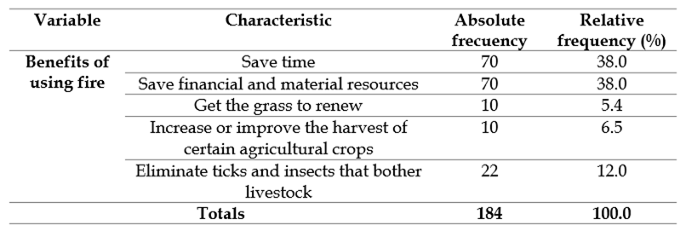
Fire can affect soil properties depending on a series of factors, such as the severity of the fire and the type of soil (Mataix-Solera et al., 2011). The perception of the producers surveyed about the effects caused by the fire can be described as very high. So much so that 100.00 % of those surveyed indicated that fire causes negative effects on the soil and the environment. Among the negative effects they mentioned air pollution and hydrological cycles, the destruction of soil layers and the loss of soil biological activity.
The 75.7 % of those surveyed said that they do know alternatives for not having to use fire, mentioning manual cleaning and not burning the stubble in order to use it as soil cover. According to (Bonfim et al., 2003) in the PESD, Brazil, 90.4 % stated that they knew of alternatives to not use fire, mentioning manual weeding among them. However, Araya-Bravo, Duprat-Sáez and Parra-Olave (2009) propose replacement alternatives to the use of fire after harvesting, whose information will allow the fire user to opt for one that is more environmentally friendly and viable in financial and economic terms. In this sense, they propose: composting, vermiculture and vermicomposting, use and management of stubble, zero tillage, waste conversion, charcoal production, feed production for ruminants, management of branches, woody material and unwanted species, silvopastoralism, preventive forestry and industrial use of waste.
Prevention measures to use fire and extinction
The main prevention measures taken into account in the locality to use the fire were to build gaps around the area to be burned and to observe the speed and direction of the wind, characteristics that were mentioned 70 and 69 times, respectively, for a total percentage of 74.7 % (Table 7). This result coincides with that reported by both Bonfim et al. (2003) in the PESB, Brazil, as well as by De Assunção, Tetto and Batista (2017) in Tocantins, Brazil and by Ramos-Rodríguez et al. (2021) in Ayacucho, Ecuador.
Table 7. - Absolute and relative frequencies of prevention measures to use fire at the Gaspar site, Convento parish

It is interesting to note that 68.8 % of those surveyed responded affirmatively when asked if their work area has ever been affected by fire coming from outside it. It can be calculated that this has occurred an average of 1.46 times in the last five years. However, 96.3 % said that the fire had not escaped the area planned to burn (Table 8). Regardless of the above, the vast majority of fires that occur in the world are of anthropic origin, caused mainly by land use change activities (Carrillo-García et al., 2012). Many farmers use fire as the main tool to clear the land, which is used to grow basic products such as corn and beans, or to promote the regrowth of grasslands. The misuse of fire frequently generates the spread of large and severe fires that not only destroy wild flora and fauna, but also directly affect the population in general (Rodríguez-Trejo and Fulé 2003).
Table 8. - Fire escape from the planned burning area and affectation of the work area by fires that come from the adjoining Gaspar site, Convento parish

To extinguish the fires that have gotten out of control, 52.2 % of 23 respondents who answered this question said that they call or ask the neighbors for help. While calling friends, relatives or the authorities corresponded percentages of 30.4; 13.0 and 4.3 %, respectively. Regarding the combat technical variables, equipment used for combat and personal protection equipment used both for burning and for combat, according to the people who answered these questions, the most used techniques are water and land with percentages of 35.1 and 29.7 %, respectively. The most used tools were machetes and tree branches with percentages of 39.4 and 27.3 %, respectively, and the most mentioned protective equipment was boots (68.8% of the total) (Table 9). A culture is observed in terms of fighting fires that escape from the areas that are expected to burn. Corresponding to this, the FAO (2011) points out that agricultural practices, such as slash-and-burn and/or shifting cultivation by local communities, have long been implicated as a major cause of wildfires. Nevertheless, keep in mind that communities are also part of the solution, as they often use fire in a positive way to manage the landscape.
Training on the use of fire and forest fires
The lack of training on the use of fire and forest fires in the studied area is evident when 55 of the respondents (78.6 %) express that they have not received training on these issues in the last five years. The 15 individuals who said they had received training stated that the trainers came from the Ministry of the Environment and that the subject dealt with was fire prevention. Among the media through which they have received information on the use of fire and forest fires, television ranked first, being mentioned 64 times (43.2 %) followed by radio with 53 mentions (35.8 %). They also mentioned family and friends (2.0 %) and others (4.1 %) among those who mentioned newspapers and social networks. Corresponding to this, in Tocantins, Brazil, only 15.0% of residents reported having some type of training in forest fire control (De Assunção, Tetto and Batista 2017), while in Ayacucho the lack of training was evident (Ramos-Rodríguez et al., 2021).
CONCLUSIONS
Fire continues to be used today by the rural producers of the Convento parish, for which they observe, in a general sense, adequate prevention measures, preferring to burn in the afternoon and at the end of the dry season with the objective of achieving the elimination of the greatest possible amount of fuels, formed mainly by residues of agricultural crops and weeds. This situation could be modified by establishing early burns that allow them to fulfill their objective with greater safety and less impact on the environment. The clearing of the land is done to sow or plant once the rains begin. In addition to this, producers must be trained specifically regarding alternatives to the use of fire, the vast majority of which are unaware.
REFERENCIAS BIBLIOGRÁFICAS
ARAYA-BRAVO, J., DUPRAT SÁEZ, C. y PARRA OLAVE, M., 2009. Alternativas de reemplazo a las quemas de residuos agrícolas y forestales [en línea]. Ministerio de Agricultura. Gobierno de Chile. Disponible en: https://www.prevencionincendiosforestales.cl/documento /alternativas-de-reemplazo-a-las-quemas-de-residuos-agricolas-y-forestales/. [ Links ]
ASSUNÇÃO, R. de, TETTO, A.F. y BATISTA, A.C., 2017. O uso tradicional do fogo no assentamento Vale Verde, em Gurupi / TO. Espacios [en línea], vol. 38, no. 17. ISSN 0798-1015. Disponible en: http://www.revistaespacios.com/a17v38n17/a17v38n17p19.pdf. [ Links ]
BONFIM, V.R., RIBEIRO, G.A., SILVA, E. y BRAGA, G.M., 2003. Diagnóstico do uso do fogo no entorno do Parque Estadual da Serra do Brigadeiro (PESB), MG. Revista Árvore [en línea], vol. 27, no. 1, pp. 87-94. DOI 10.1590/s0100-67622003000100012. Disponible en: https://www.scielo.br/j/rarv/a/kwyt7DFJbZXmxZj4sqLg5Kz/?format=pdf&lang=pt. [ Links ]
CARRILLO-GARCÍA, L.R., RODRÍGUEZ-TREJO, D.A., TCHIKOUÉ, H., MONTERROSO-RIVAS, I.A. y SANTILLAN-PÉREZ, J., 2012. Análisis espacial de peligro de incendios forestales en Puebla, México. Interciencia [en línea], vol. 37, no. 9, pp. 678-683. ISSN 0378-1844. Disponible en: http://www.redalyc.org/articulo.oa?id=33925502012. [ Links ]
CARROLL, M.S., EDGELEY, C.M. y NUGENT, C., 2021. Traditional use of field burning in Ireland: History, culture and contemporary practice in the uplands. International Journal of Wildland Fire [en línea], vol. 30, no. 6, pp. 399-409. ISSN 1049-8001. DOI 10.1071/WF20127. Disponible en: https://www.publish.csiro.au/wf/pdf/WF20127. [ Links ]
FOOD AND AGRICULTURE ORGANIZATION OF THE UNITED NATIONS, 2011. Community-based fire management: A review. [en línea] FAO: Forest. Roma, Italia:. ISBN 978-92-5-107094-9. Disponible en: https://www.fao.org/3/i2495e/i2495e.pdf. [ Links ]
FRANCOS, M. y ÚBEDA, X., 2021. Prescribed fire management. Current Opinion in Environmental Science and Health [en línea], vol. 21, pp. 100-250. ISSN 2468-5844. DOI 10.1016/j.coesh.2021.100250. Disponible en: https://sci-hub.wf/10.1016/J.COESH.2021.100250. [ Links ]
GOBIERNO AUTÓNOMO DESENTRALIZADO DE LA PARROQUIA RURAL CONVENTO. 2018. Plan de desarrollo y ordenamiento territorial de la Parroquia Convento 2017-2021. [en línea]. GAD Parroquia Rural Convento. Disponible en: https://multimedia.planificacion.gob.ec/PDOT/descargas.html. [ Links ]
HESSELN, H., 2018. Wildland Fire Prevention: a Review. Current Forestry Reports [en línea], vol. 4. DOI 10.1007/s40725-018-0083-6. Disponible en: https://sci-hub.wf/10.1007/s40725-018-0083-6. [ Links ]
GUTIÉRREZ-NAVARRO, A., GARCÍA-BARRIOS, L.E., PARRA-VÁZQUEZ, M. y ROSSET, P., 2017. De la supresión al manejo del fuego en la Reserva de la Biosfera La Sepultura, Chiapas: perspectivas campesinas. Región y Sociedad [en línea], vol. 29, no. 70, pp. 31-70. ISSN 2448-4849. Disponible en: https://www.redalyc.org/articulo.oa?id=10253202002. [ Links ]
HUERTAS-HERRERA, A., BAPTISTE-BALLERA, B.L.G., TORO-MANRÍQUEZ, M. y HUERTAS-RAMÍREZ, H., 2019. Manejo de la quema de pastizales de sabana inundable: Una mirada del pueblo originario Sáliva en Colombia. Chungará (Arica) Revista de Antropología Chilena [en línea], vol. 51, no. 1, pp. 167-176. DOI 10.4067/s0717-73562018005002401. Disponible en: https://scielo.conicyt.cl/pdf/chungara/v51n1/0717-7356-chungara-02401.pdf. [ Links ]
IDE, J., OHASHI, M., KÖSTER, K., BERNINGER, F., MIURA, I., MAKITA, N., YAMASE, K., PALVIAINEN, M. y PUMPANEN, J., 2020. Molecular composition of soil dissolved organic matter in recently-burned and long-unburned boreal forests. International Journal of Wildland Fire [en línea], vol. 29, no. 6, pp. 541-547. ISSN 1049-8001. DOI 10.1071/WF19085. Disponible en: https://www.researchgate.net/publication/339220992_Molecular_composition_of_soil_dissolved_organic_matter_in_recently -burned_and_long-unburned_boreal_forests. [ Links ]
MATAIX-SOLERA, J., CERDÁ, A., ARCENEGUI, V., JORDÁN, A. y ZAVALA, L.M., 2011. Fire effects on soil aggregation: A review. Earth-Science Reviews [en línea], vol. 109, no. 1-2, pp. 44-60. ISSN 0012-8252. DOI 10.1016/j.earscirev.2011.08.002. Disponible en: https://www.sciencedirect.com/science/article/abs/pii/S0012825211001322. [ Links ]
MORGAN, G.W., TOLHURST, K.G., POYNTER, M.W., COOPER, N., MCGUFFOG, T., RYAN, R., WOUTERS, M.A., STEPHENS, N., BLACK, P., SHEEHAN, D., LEESON, P., WHIGHT, S. y DAVEY, S.M., 2020. Prescribed burning in south-eastern Australia: history and future directions. Australian Forestry [en línea], vol. 83, no. 1, pp. 4-28. DOI 10.1080/00049158.2020.1739883. Disponible en: https://sci-hub.wf/10.1080/00049158.2020.1739883. [ Links ]
NASA 2021 Prediction of Worldwide Energy Resources. [Online]. NASA. Disponible en: https://power.larc.nasa.gov/data-access-viewer/ [Acceso Nov. 29, 2021]. [ Links ]
NGHALIPO, E., JOUBERT, D., THROOP, H. y GROENGROEFT, A., 2018. The effect of fire history on soil nutrients and soil organic carbon in a semi-arid savanna woodland, central Namibia. African Journal of Range and Forage Science [en línea], vol. 36, no. 1, pp. 9-16. ISSN 1727-9380. DOI 10.2989/10220119.2018.1526825. Disponible en: https://www.researchgate.net/publication/329819429_The_effect_of_fire_history_on_soil_nutrients_and_soil_organic_carbon_in_a_semi -arid_savanna_woodland_central_Namibia. [ Links ]
PÉREZ-CABELLO, F., ECHEVERRÍA, M.T., DE LA RIVA, J. y IBARRA, P., 2014. Apuntes sobre los efectos de los incendios forestales y restauración ambiental de área quemadas. Estado de la cuestión y principios generales. Geographicalia [en línea], no. 59-60, pp. 295-308. ISSN 0210-8380. DOI 10.26754/ojs_geoph/geoph.201159-60839. Disponible en: https://papiro.unizar.es/ojs/index.php/geographicalia/article/view/839. [ Links ]
PIVELLO, V.R., 2011. The use of fire in the cerrado and Amazonian rainforests of Brazil: Past and present. Fire Ecology [en línea], vol. 7, no. 1, pp. 24-39. ISSN 1933-9747. DOI 10.4996/fireecology.0701024. Disponible en: https://link.springer.com/article/10.4996/fireecology.0701024. [ Links ]
RAMOS-RODRÍGUEZ, M.P., CEDEÑO-CEDEÑO, D.S., BATISTA, A.C., JIMENEZ-GONZÁLEZ, A., MANRRIQUE-TOALA, T.O. y TERRO, A.F., 2021. Usos tradicionales del fuego en la Parroquia Ayacucho, Cantón Santa Ana, provincia Manabí, Ecuador. Revista Forestal Mesoamericana Kurú [en línea], vol. 18, no. 43, pp. 41-52. [Consulta: 23/08/2021]. DOI 10.18845/rfmk.v19i43.5807. Disponible en: Disponible en: https://revistas.tec.ac.cr/index.php/kuru/article/view/5807 . [ Links ]
RODRÍGUEZ-TREJO, D.A. y FULÉ, P.Z., 2003. Fire ecology of Mexican pines and a fire management proposal. International Journal of Wildland Fire [en línea], vol. 12, no. 1, pp. 23-37. ISSN 1049-8001. DOI 10.1071/WF02040. Disponible en: https://www.researchgate.net/publication/228551647_Fire_ecology_of_Mexican_pines_and_a_fire_management_proposal. [ Links ]
RODRÍGUEZ-TREJO, D.A., MARTÍNEZ-HERNÁNDEZ, P.A., ORTIZ-CONTLA, H., CHAVARRÍA-SÁNCHEZ, M.R. y HERNÁNDEZ-SANTIAGO, F., 2011. The present status of fire ecology, traditional use of fire, and fire management in Mexico and Central America. Fire Ecology [en línea], vol. 7, no. 1, pp. 40-56. ISSN 1933-9747. DOI 10.4996/fireecology.0701040. Disponible en: https://link.springer.com/article/10.4996/fireecology.0701040. [ Links ]
SOARES, R.V., BATISTA, A.C. y TETTO, A.F., 2017. Incêndios florestais: controle, efeito e uso do fogo. Segunda Ed. Curitiba: Gráfica Capital. ISBN: 978-85-904353-6-5. [ Links ]
SOUSA-GOMES, V. y PAULETTO, D., 2018. Uso tradicional do fogo: Avaliação de queima controlada na agricultura de subsistência exercida na Reserva Extrativista Tapajós-Arapiuns. Revista Terceira Margem Amazônia [en línea], vol. 3, no. 11, pp. 168-177. ISSN 2525-4812. DOI 10.36882/2525-4812.2018v3i11p%25p. Disponible en: http://www.revistaterceiramargem.com/index.php/terceiramargem/article/view/239/177. [ Links ]
SOUZA-ALONSO, P., SAIZ, G., GARCÍA, R.A., PAUCHARD, A., FERREIRA, A. y MERINO, A., 2022. Post-fire ecological restoration in Latin American forest ecosystems: Insights and lessons from the last two decades. Forest Ecology and Management [en línea], vol. 509. ISSN 0378-1127. DOI 10.1016/j.foreco.2022.120083. Disponible en: https://www.sciencedirect.com/science/article/pii/S0378112722000779. [ Links ]
Received: July 07, 2022; Accepted: August 06, 2022














